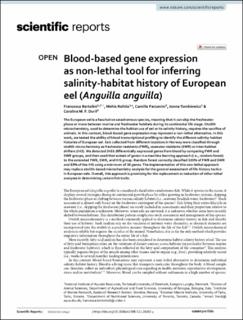| dc.contributor.author | Bertolini, Francesca | |
| dc.contributor.author | Rohtla, Mehis | |
| dc.contributor.author | Parzanini, Camilla | |
| dc.contributor.author | Tomkiewicz, Jonna | |
| dc.contributor.author | Durif, Caroline | |
| dc.date.accessioned | 2023-01-17T13:02:12Z | |
| dc.date.available | 2023-01-17T13:02:12Z | |
| dc.date.created | 2023-01-08T15:14:31Z | |
| dc.date.issued | 2022 | |
| dc.identifier.citation | Scientific Reports. 2022, 12 (1), . | en_US |
| dc.identifier.issn | 2045-2322 | |
| dc.identifier.uri | https://hdl.handle.net/11250/3044045 | |
| dc.description.abstract | The European eel is a facultative catadromous species, meaning that it can skip the freshwater phase or move between marine and freshwater habitats during its continental life stage. Otolith microchemistry, used to determine the habitat use of eel or its salinity history, requires the sacrifice of animals. In this context, blood-based gene expression may represent a non-lethal alternative. In this work, we tested the ability of blood transcriptional profiling to identify the different salinity-habitat histories of European eel. Eels collected from different locations in Norway were classified through otolith microchemistry as freshwater residents (FWR), seawater residents (SWR) or inter-habitat shifters (IHS). We detected 3451 differentially expressed genes from blood by comparing FWR and SWR groups, and then used that subset of genes in a machine learning approach (i.e., random forest) to the extended FWR, SWR, and IHS group. Random forest correctly classified 100% of FWR and SWR and 83% of the IHS using a minimum of 30 genes. The implementation of this non-lethal approach may replace otolith-based microchemistry analysis for the general assessment of life-history tactics in European eels. Overall, this approach is promising for the replacement or reduction of other lethal analyses in determining certain fish traits. | en_US |
| dc.language.iso | eng | en_US |
| dc.title | Blood-based gene expression as non-lethal tool for inferring salinity-habitat history of European eel (Anguilla anguilla) | en_US |
| dc.title.alternative | Blood-based gene expression as non-lethal tool for inferring salinity-habitat history of European eel (Anguilla anguilla) | en_US |
| dc.type | Peer reviewed | en_US |
| dc.type | Journal article | en_US |
| dc.description.version | publishedVersion | en_US |
| dc.source.pagenumber | 12 | en_US |
| dc.source.volume | 12 | en_US |
| dc.source.journal | Scientific Reports | en_US |
| dc.source.issue | 1 | en_US |
| dc.identifier.doi | 10.1038/s41598-022-26302-y | |
| dc.identifier.cristin | 2102758 | |
| dc.relation.project | Nordisk ministerråd: 200005 | en_US |
| cristin.ispublished | true | |
| cristin.fulltext | original | |
| cristin.qualitycode | 1 | |
